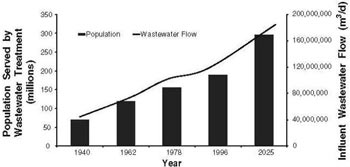CADDIS Volume 2: Sources, Stressors & Responses

What are wastewater inputs?
Urbanization often involves the input of wastewaters into streams and rivers. Common wastewater sources in urban streams include:
Wastewater treatment plant (WWTP) effluents: permitted municipal sewage discharges (Fig 10), treated to varying degrees (see Table 3)
Industrial effluents: permitted discharges from industrial facilities
Accidental or unpermitted discharges
Sanitary sewer overflows: wet weather overflows resulting in direct discharge of domestic and other wastewaters into streams and rivers
Combined sewer overflows (CSOs): wet weather overflows resulting in direct discharge of surface runoff and domestic and other wastewaters into streams and rivers
Sewer pipes: leakage from broken, blocked or aging infrastructure
Septic systems: leachate from septic tanks (usually in less densely developed areas)
Stressors associated with wastewater inputs
Numerous stressors may be associated with wastewater inputs, including:
- ↑ nutrients
[Gücker et al. 2006, Carey & Migliaccio 2009] - ↓ dissolved oxygen (↑ biological oxygen demand)
[Ortiz & Puig 2007] - ↑ pathogens
[Gibson et al. 1998, Frenzel & Couvillion 2002] - ↑ metals (e.g., copper, mercury, cadmium, lead, iron)
[Nedeau et al. 2003] - ↑ pharmaceuticals and personal care products
[Kolpin et al. 2002, Watkinson et al. 2009] - ↑ toxics (e.g., alkylphenols, pesticides, PAHs)
[Kolpin et al. 2002, Phillips & Chalmers 2009] - ↑ dissolved solids (e.g., chloride, sulfate, specific conductance)
[Hur et al. 2007, Rose 2007] - ↑ stream discharge
[Nedeau et al. 2003, Barber et al. 2006, Carey & Migliaccio 2009] - ↑ temperature
[Nedeau et al. 2003, Kinouchi 2007]
Click below for more information on specific topics




Adapted from U.S. EPA. 2000. Progress in Water Quality: An Evaluation of the National Investment in Municipal Wastewater Treatment. U.S. Environmental Protection Agency, Office of Water, Washington DC. EPA-832-R-00-008.

Courtesy of USGS.
| Pollutant | Typical Treatment Efficiencies (% inflow concentrations) |
||
|---|---|---|---|
Sewage Ponds |
Secondary treatment |
Advanced Treatment |
|
| BOD* | 50-95 | 95 | 95 |
| Nitrogen | 43–80 | 50 | 87 |
| Phosphorus | 50 | 51 | 85 |
| Suspended solids | 85 | 95 | 95 |
| Metals | Variable | Variable | Variable |
| *BOD = biological oxygen demand. Modified from Baker LA. 2009. New concepts for managing urban pollution. Pp. 69-91 in: Baker LA (ed). The Water Environment of Cities. Springer Science+Business Media, LLC. |
|||
